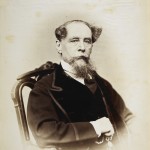And a Happy Dickens Year to you all! With so much going on this year to mark the bicentenary of the author’s birth, we must head to the British Library to see A Hankering after Ghosts: Charles Dickens and the Supernatural. The exhibition explores the many ways in which Dickens uses supernatural phenomena in his works – far beyond the obvious themes of A Christmas Carol. As ever, the visionary writer picked up on the zeitgeist of scientific, technological and philosophical developments.
Dickens developed an interest in the macabre from an early age and was greatly affected by the things he read in his youth. One of the teenage Dickens’ favourite reads was The Terrific Register a penny weekly magazine which covered such topics as murder, ghosts, incest and cannibalism. He claimed the stories ‘frightened the very wits out of [his] head’.
As an adult he was caught up in the ‘mesmeric mania’ that swept Britain and the power of the human mind. He believed that all supernatural manifestations must have rational explanations, but his investigations into animal magnetism and psychology showed him that science could be as chilling as any ghost story.
Because of this interest, the author became wonderfully adept at suspending readers between psychological and supernatural explanations in his fiction. And he also used some techniques in his own life. In a letter from Dickens to his wife, Catherine in 1853, the author alludes to a marital disagreement that arose after Catherine became jealous of the close attention her husband was paying to a lady named Augusta de la Rue. Dickens used mesmerism to treat her nervous condition after he learnt how to mesmerise people himself.
Andrea Lloyd, curator of the exhibition, says: ‘Dickens is already closely aligned with Victorian ghost stories in many people’s minds largely because of the success of A Christmas Carol. However, Dickens touches upon the supernatural in many of his other works, revealing his thoughts about unexplained phenomena, which in turn reflect the evolving scientific theories and beliefs that were prevalent in 19th century England.
‘At this time people were debating the virtues of mesmerism and animal magnetism, getting caught up in the Spiritualism craze that arrived from America, and actively investigating and recording ghostly phenomena. By engaging with this vogue for the supernatural, and by tapping into the Victorian attraction to the macabre, Dickens created some of his finest works.’ As part of the schools programme to accompany the exhibition, a series of lectures will be offered to AS and A-Level students. The lectures will support the transition from A-Level to undergraduate level, giving students a taste for university-style lectures. Students will have the chance to explore the exhibition independently, looking at original collection items, either before or after the lecture.
The exhibition runs in the British Library’s Folio Society Gallery until March 4. For further details, visit www.bl.uk.




